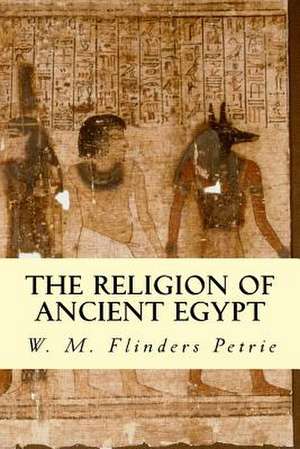The Religion of Ancient Egypt
Autor W. M. Flinders Petrieen Limba Engleză Paperback
| Toate formatele și edițiile | Preț | Express |
|---|---|---|
| Paperback (4) | 38.00 lei 3-5 săpt. | |
| CreateSpace Independent Publishing Platform – | 38.00 lei 3-5 săpt. | |
| BLURB INC – 5 feb 2019 | 78.23 lei 17-24 zile | |
| BLURB INC – 17 feb 2019 | 78.51 lei 17-24 zile | |
| Blurb – 22 mai 2019 | 104.31 lei 6-8 săpt. | |
| Hardback (2) | 141.93 lei 3-5 săpt. | |
| Binker North – 22 mar 2020 | 141.93 lei 3-5 săpt. | |
| Blurb – 9 ian 2019 | 205.08 lei 6-8 săpt. |
Preț: 38.00 lei
Nou
Puncte Express: 57
Preț estimativ în valută:
7.27€ • 7.62$ • 6.01£
7.27€ • 7.62$ • 6.01£
Carte disponibilă
Livrare economică 21 martie-04 aprilie
Preluare comenzi: 021 569.72.76
Specificații
ISBN-13: 9781503110557
ISBN-10: 1503110559
Pagini: 54
Dimensiuni: 152 x 229 x 3 mm
Greutate: 0.09 kg
Editura: CreateSpace Independent Publishing Platform
ISBN-10: 1503110559
Pagini: 54
Dimensiuni: 152 x 229 x 3 mm
Greutate: 0.09 kg
Editura: CreateSpace Independent Publishing Platform
Notă biografică
Sir William Matthew Flinders Petrie, FRS, FBA (3 June 1853 - 28 July 1942), commonly known as Flinders Petrie, was an English Egyptologist and a pioneer of systematic methodology in archaeology and preservation of artefacts. He held the first chair of Egyptology in the United Kingdom, and excavated many of the most important archaeological sites in Egypt in conjunction with his wife, Hilda Petrie.[3] Some consider his most famous discovery to be that of the Merneptah Stele,[4] an opinion with which Petrie himself concurred.[5] Petrie developed the system of dating layers based on pottery and ceramic findings In his teenage years, Petrie surveyed British prehistoric monuments[10] (commencing with the late Romano-British 'British Camp' that lay within yards of his family home in Charlton) in attempts to understand their geometry (at 19 producing the most accurate survey of Stonehenge). His father had corresponded with Piazzi Smyth about his theories of the Great Pyramid] and Petrie travelled to Egypt in early 1880 to make an accurate survey of Giza, making him the first to properly investigate how they were constructed (many theories had been advanced on this, and Petrie read them all, but none were based on first hand observation or logic).[11] Petrie's published reports of this triangulation survey, and his analysis of the architecture of Giza therein, was exemplary in its methodology and accuracy, disproved Smyth's theories and still provides much of the basic data regarding the pyramid plateau to this day. On that visit, he was appalled by the rate of destruction of monuments (some listed in guidebooks had been worn away completely since then) and mummies. He described Egypt as "a house on fire, so rapid was the destruction" and felt his duty to be that of a "salvage man, to get all I could, as quickly as possible and then, when I was 60, I would sit and write it all. Returning to England at the end of 1880, Petrie wrote a number of articles and then met Amelia Edwards, journalist and patron of the Egypt Exploration Fund (now the Egypt Exploration Society), who became his strong supporter and later appointed him as Professor at her [chair at University College London]. Impressed by his scientific approach, they offered him work as the successor to Édouard Naville. Petrie accepted the position and was given the sum of £250 per month to cover the excavation's expenses. In November 1884, Petrie arrived in Egypt to begin his excavations.
